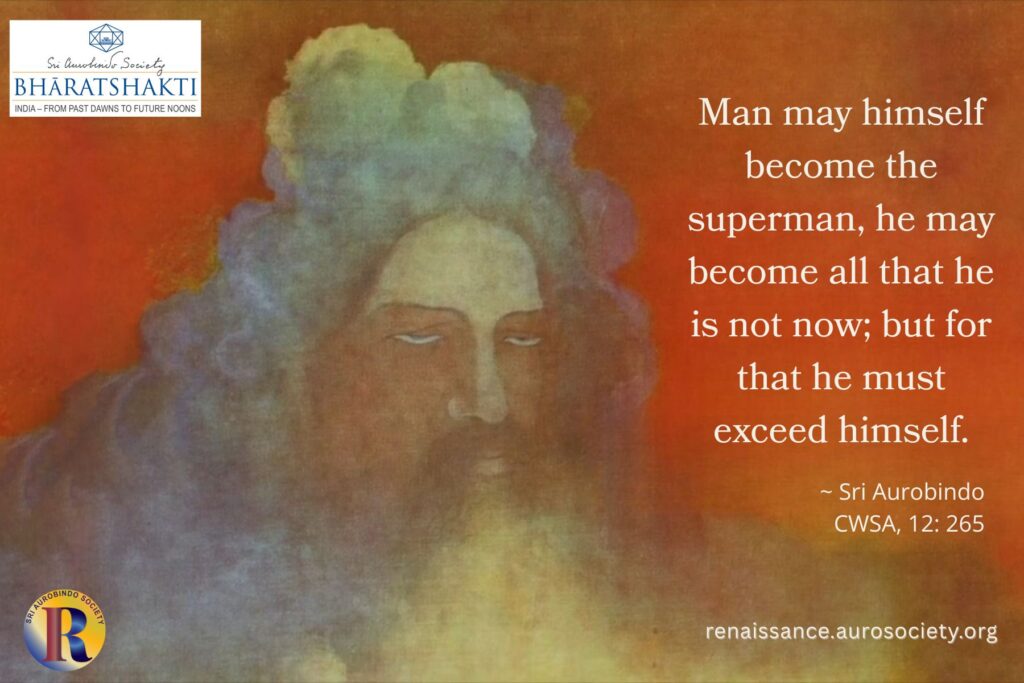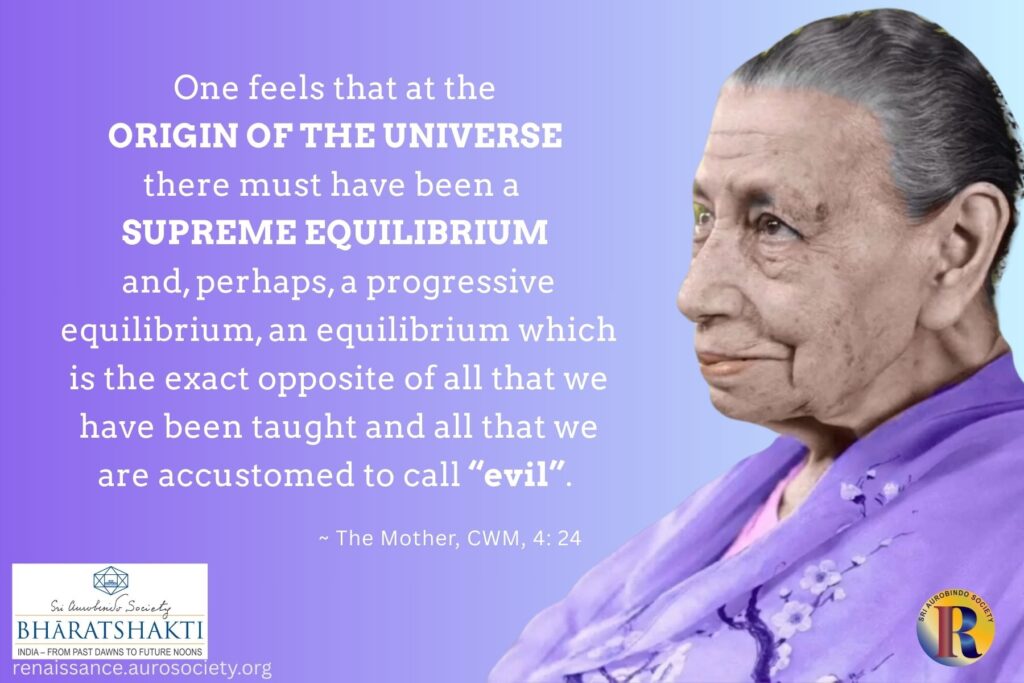Editor’s note: Pointing out the nature of religion, the author highlights how religion while being a means of social cohesion can also become a source of conflict. He emphasises that because most religious oriented people tend to focus only on the external aspects, religion as such does not help in inner transformation. For that one must go on an inner search, the path of yoga.

The word Religion usually refers to a set of activities and pattern of behaviour that shows one’s allegiance to a particular belief system or faith tradition. These activities include visiting churches, temples or mosques, petitionary prayers, performing rituals, keeping observances like fasting, celebrating festivals and following a code of conduct as laid down in the religious texts or tradition. In other words, religion is a way of conducting life in the outer world. For the majority of the human mass, these acts constitute the sum of their religion. They do not know of any other religion.
We call “religion” any concept of the world or the universe which is presented as the exclusive Truth in which one must have absolute faith, generally because this Truth is declared to be the result of a revelation.
The Mother, CWM, Vol. 15, p. 30
Often adherents of a religion begin to emphasize the uniqueness and specialty of their way of religious life. Such vehement clinging, especially to the outer aspects of religious behaviour then gives rise to conflict with the adherents of other belief systems.
Moreover, the strict adherence to codes of conduct laid down centuries ago, in another time and in another context may give rise to its own set of problems when such rigidity clashes with the cultural mores of the modern world. When times move and the centuries march, the old customs and cultures become outdated. What was appropriate Yuga Dharma and right conduct in a particular age, may become an awful anachronism in another age. That is why continuous reforms become necessary in every religion.
* * *
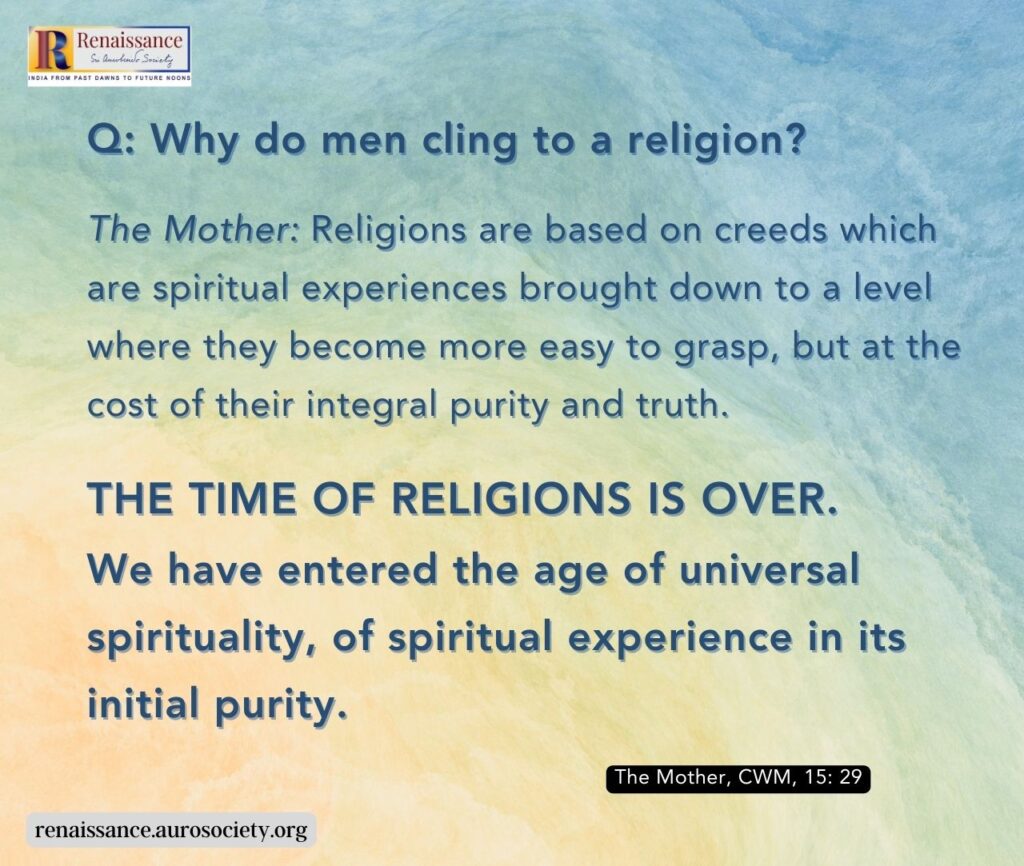
Even in the present times, we find an unfortunate trend where some religions are still insistent on continuing with their rigidity. They even try to cut and fit the outer life of the 21st century into the Procrustean Bed of the customs of the medieval or the pre-scientific age. As a result, they are perpetually in a conflict. Such conflicts are not only with other religions which have gone through several internal reforms particularly after the advent of rational age, but also with the scientific, rational and the modern digital age.
Read:
Sri Aurobindo on the Religion as the Law of Life
The rules for conduct of the outer life should not be cast in iron because they become outdated with the passage of time. Religion is like the bark of the tree which also must grow along with the tree – otherwise it chokes the tree. A living tree would cast off its old bark and create for itself a new bark according to its growth.
Ramakrishna put it pithily: The Mughal Era currency is of no use in British India. Though religion has its place and utility because it provides a sense of community and social cohesion, the same religion when it veers too much on the side of rigidity and inflexibility, can get diverted from its essential purpose and lead to conflict situations.
Religion may bring about an improvement in the conduct of its adherents, may also improve community cohesion. However, it does nothing to transform the inner consciousness which is the true source of brotherhood. The soul and Spirit of man remain untouched.
And that brings to us to Yoga.
Yoga is about the inner life. Its aim is to bring about a transformation in our consciousness that is too often embroiled right now, in the material and outer aspects of life.
You must not confuse a religious teaching with a spiritual one.
Religious teaching belongs to the past and halts progress.
Spiritual teaching is the teaching of the future—it illumines the consciousness and prepares it for future realisation.
Spiritual teaching is above religions and strives towards a global Truth.
It teaches us to enter into direct relation with the Divine.
~ The Mother, CWM, Vol. 15, p. 30
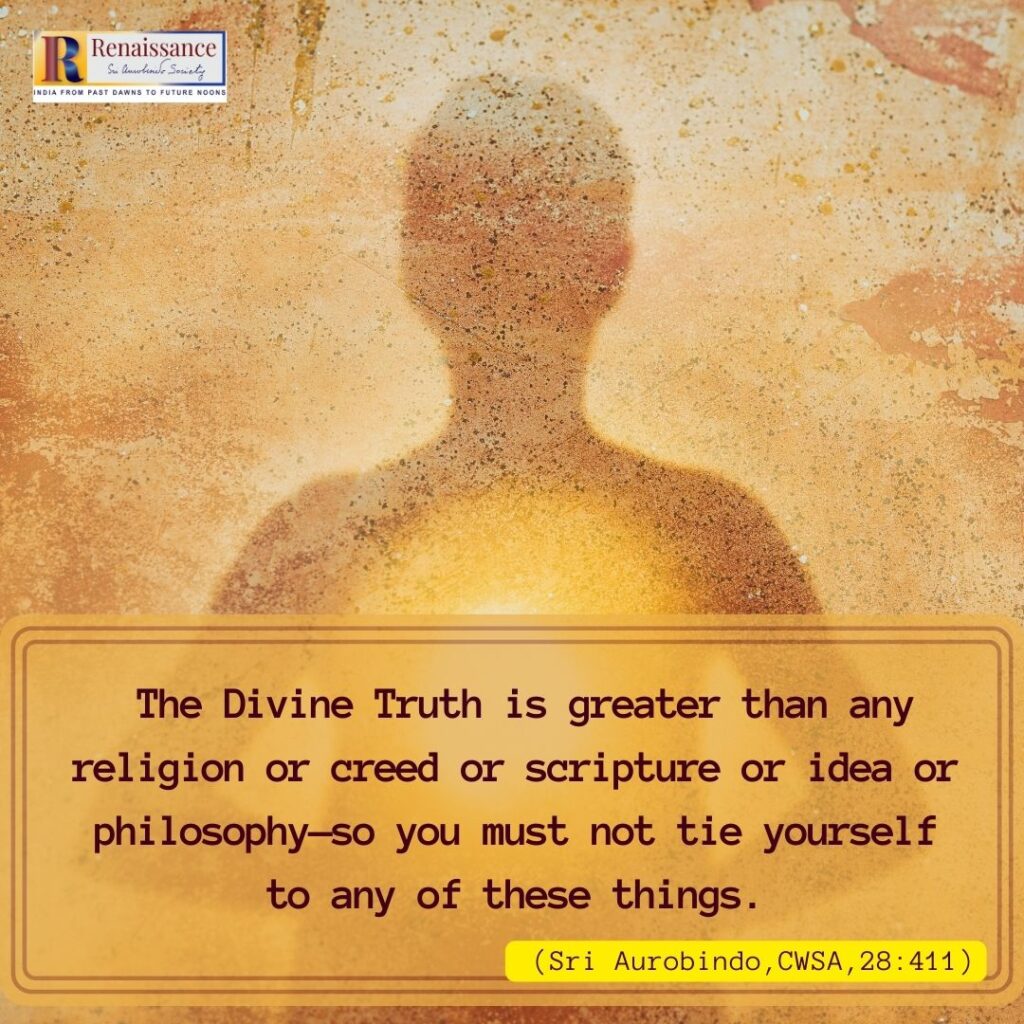
Right now, our lives are consumed by the struggles, knocks and shocks of life. All our energies are spent in coping with the endless challenges that life keeps throwing up on a daily basis. We curse and struggle; endure stress and anxiety; are always racing against time to meet deadlines and suffer from time-poverty. We don’t seem to live; but always hoping to live tomorrow.
In the meantime, the sand of life keeps slipping through our fingers. We never seem to get on top of things and circumstances. The reason is that we are always trying to manage things from the level of the mind. Perhaps a calm and serene mind could have handled all this very well, but we do not have the faintest idea as to how to calm the mind. And the mind that is fragmented in a thousand ways under the onslaught of the raging tempest of our desires, pulls, anxieties, hopes and expectations, is simply not up to the job.
The mind with which we expect to cope with the world, fails miserably because the mind itself is in turmoil.
It is like trying to cross the raging sea of life with a leaky vessel and a broken rudder. That is why life is a constant struggle without a moment’s peace.
We are miserable because we have not gained a higher vantage point other than the mind. Because we are not even sure whether there is anything higher than the mind! That higher vantage point, that higher perspective, is the Spirit.
When we transcend the life of the mind and discover the life of the Spirit, the turmoil of the mind quietens down. We never really solve the problems of life once and for all because life constantly throws up problems. But when we enter the life of the Spirit, while the problems are still there they lose their power to disturb our inner sanctuary of peace. And hence we are able to deal with the problems with calmness and serenity. Because now we are able to view things from the higher stand point of the Spirit.
Also read:
Stilling the Mind and Tuning into Inner Silences
Spirit is that higher perspective which gives us a firm hold on life. Yoga can be referred to as Sadhana or the Inner Path. The aim is to discover and experience the Divine which lies hidden within oneself. Sri Aurobindo writes in The Human Cycle:
The deepest heart, the inmost essence of religion, apart from its outward machinery of creed, cult, ceremony and symbol, is the search for God and the finding of God. Its aspiration is to discover the Infinite, the Absolute, the One, the Divine. . . a casting of every part of our existence out of its normal status into an uprush of man towards the Divine.
~ CWSA, Vol. 25, p. 131
This, then, is Yoga. A total transformation of our consciousness and a discovery of the higher dimension of the Spirit. As Sri Aurobindo has repeatedly emphasized that the life of the Spirit is the final culmination of the evolution of the consciousness of man. The progressive stages of this evolution are: Matter > Life > Mind > Spirit.
Religion ends at the level of the mind. But it is Yoga that touches the dimension of the Spirit. Unless we discover this higher dimension in life, our lives would remain forever trapped in the whirlpool of anxieties. And this search is an inner search.
The Christian mystic Hugo of Saint Victor said that the way to ascend to God is to descend into oneself. This descent into oneself to discover God, is Yoga. It is not there in the outside world. It is not there in the religion of temples and churches, in rituals and observances or in the code of conduct.
We may get lost in searching for God in the outside world. Much like the Himalayan musk deer that keeps about running here and there looking for the pleasant scent whose source lies in its own navel! Since the musk deer doesn’t know that, it keeps searching. We too go on a wild goose chase in the outside world looking for peace and fulfilment there — quite oblivious to the fact that this is a transient, joyless world; anityamasukhaṁ lokamimaṁ as pointed by the Gita (Chapter IX, Verse 33). Redemption lies within our own Soul, in the life of the Spirit.
We cannot endlessly keep going round in circles of pleasures and pains, joys and sorrows, triumphs and failures of life.
At some point in life, we are bound to ask Is it all there is? Nothing beyond? Even now, if we are observant, we would notice that nothing, absolutely nothing gives us any everlasting happiness. It is all transitory. Even if we have everything in life and are adjudged ‘successful’ by the world, that doesn’t give us lasting peace and joy.
A constant dissatisfaction, a kind of homesickness seems to gnaw at us at all times. Our hearts constantly say No, this is not it! Something more! But we do not know what it is. This is actually a spiritual crisis. This dissatisfaction is actually a divine dissatisfaction which is not going to be quenched by anything of this material world. This homesickness is a spiritual homesickness.
If we have ignored the life of the Spirit, we can never find peace. Saint Augustine uttered the highest wisdom when he said, “Thou hast made us for Thyself and our hearts are restless till they find rest in Thee.”
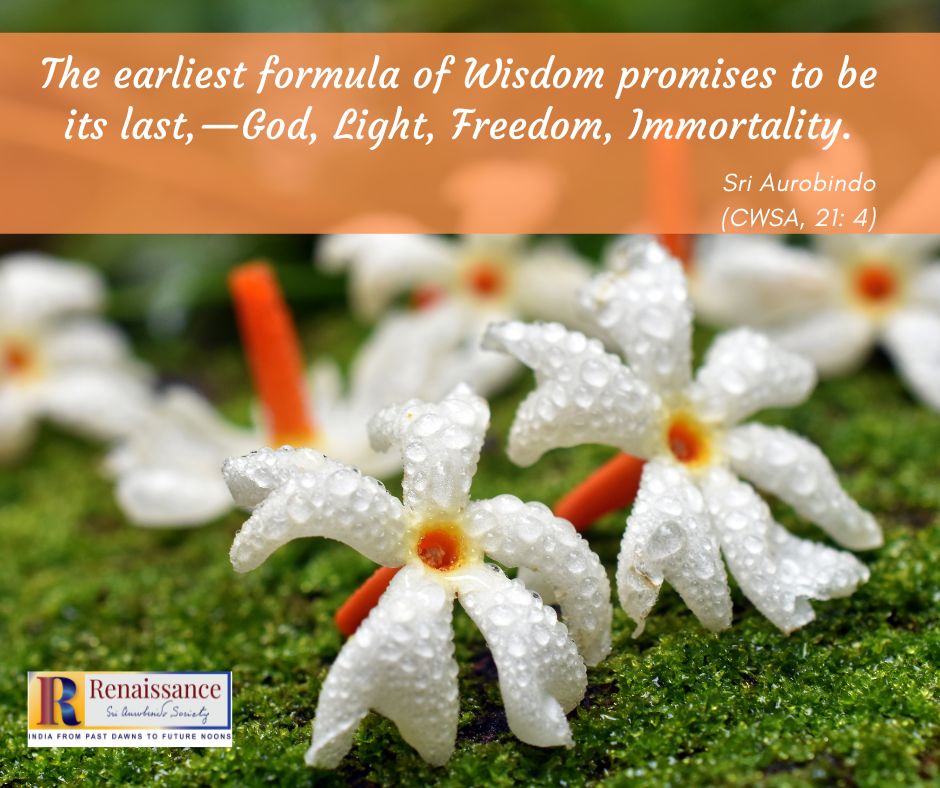
This spiritual homesickness is there because we are not home; our true home. Ramakrishna said: “As hunger and thirst arise spontaneously, so does longing for God. It is simply a matter of time. Yearning for God-realization cannot arise until one has to some extent satisfied the desires of social existence or has seen through them and been freed from them.”
Just as the desires of childhood like playing with toys naturally fall away as we begin to enjoy the adult desires of playing with adult toys like name, fame, wealth, sex, power and position; similarly, such adult toys also fall by the wayside when we discover the higher joys of the Spirit; the blissful life of the Divine.
It is narrated that once Ebrahim, the Sufi Master, came to a well. He let down the bucket, and it came up full of gold. He emptied it and let it down again, and it came up full of pearls. In a merry mood he emptied it once more. “Oh God,” he cried, “You are offering me a treasury. I know that You are all-powerful and You also know that I shall not be deluded by this. Please don’t play with me. Give me water so that I can do my washing.”
This kind of plenitude comes when we live in the Divine. Then all the treasures of this world become meaningless in this divine satisfaction, in this divine fulness.
But if we ignore the call of the Spirit, the call from the Divine, we would suffer from diseases of the inner being. In spite of being successful in the outer world, modern man is anguished and torn inside because he suffers from an inner sickness. And the symptoms of such inner sickness are: Alienation, meaninglessness, existential angst, a feeling of emptiness in spite of having everything, apathy, desacralization of life, cynicism, hopelessness and sometimes, even a death wish.
We are living but we do not know why we are living! This spiritual crisis comes in our lives because we have ignored the Spirit; shut ourselves to the call of the Divine.
However, to embark on the path of the Divine, we have to purify our base and vital nature.
Unless we purify ourselves from inside, the doors of the Spirit would not be opened for us. The terrain of the Spirit would be progressively revealed to us as our inner purification increases. Jesus declares in the Sermon on the Mount: Blessed are the pure in heart; for they shall see God.
How can we see God with our degenerate nature? With our impure hearts? Paramhamsa Yogananda explains: “Reality cannot be reflected in a consciousness ruffled by likes and dislikes, with their restless passions and desires, and the roiling emotions they engender – anger, jealousy, greed. But when the consciousness – human knowledge and feeling – is transformed, the ordinarily agitated ego gives way to the blessed calmness and soul perception.”
This is what is meant by “pure in heart”. Unless we cleanse and purify ourselves internally, unless our consciousness has become a ‘spiritual consciousness’, we remain impure in heart and shall not be able to see God.
And how do we purify and cleanse our consciousness? By practicing the various methods of sadhana given by the great masters over the ages – various paths like Meditation, Devotion, Selfless dedicated works and Spiritual knowledge which can all be put under one head: YOGA (derived from the Sanskrit word yuj – to join).
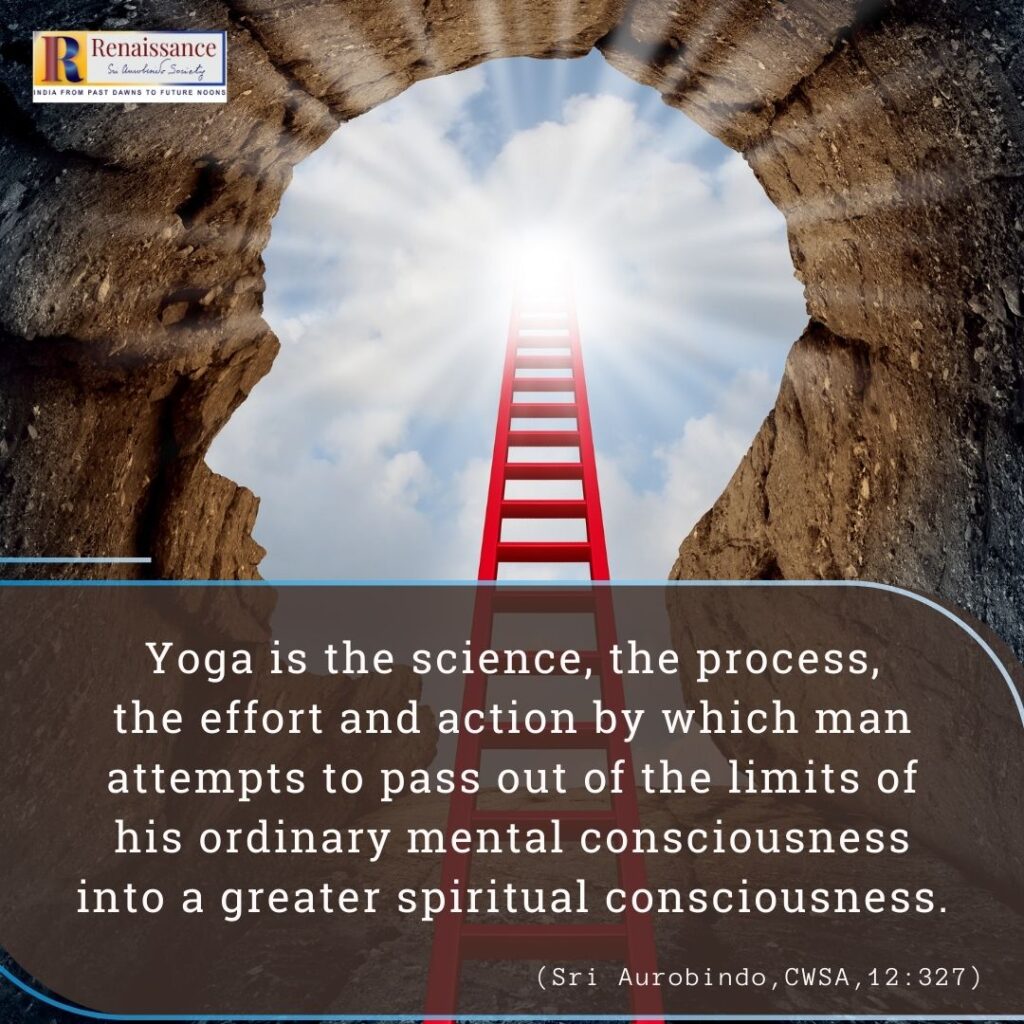
So, by Yoga we mean, union with our Divine nature. The purpose of our life is to realize our divine nature. And the path is Yoga. This is Sadhana. And a powerful expression of this verity was given by Swami Vivekananda when he declared:
Each soul is potentially divine. The goal is to manifest this divinity within by controlling nature, external and internal. Do this either by work or worship or psychic control or philosophy – by one or more or all of these – and be free.
This is the whole of religion. Doctrines or dogmas or rituals or books or temples or forms are but secondary details.
Swamiji is, in fact, describing the various paths of Yoga, i.e., Work (Karma Yoga), Worship (Bhakti Yoga), Psychic control (Raja Yoga) and Philosophy (Jnana Yoga).
And when we combine all these paths together – because Work, Devotion, Mind control and Knowledge – they are all part of our essential human nature and none is to be eschewed in favour of another, and add to it the Yoga of Perfection, that becomes Sri Aurobindo’s Integral Yoga.
~ Design: Beloo Mehra and Biswajita Mohapatra

